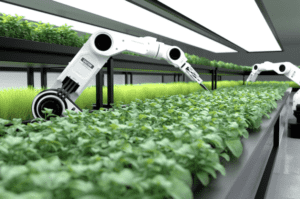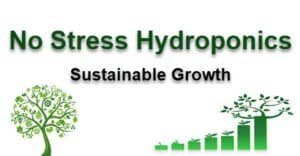Do you want to start your own hydroponic farm? It can be a great way to provide fresh produce for your family and friends, while also making a profit. In this blog post, we will teach you how to start hydroponic farming. We will cover everything from choosing the right location to set up your grow system! So, whether you are a beginner or an experienced farmer, this blog post is for you!
The Basics of Hydroponic Farming
Plants are grown in water rather than on soil in hydroponic farming. It may appear to be a difficult task, but it is not. Consider what it takes for a plant to grow: nutrients, water, air, space, light, and time. Hydroponic growing is able to fulfill all of these wants since it supplies the essential macronutrients such as NPK (nitrogen, phosphorus, and potassium), as well as other required minerals including magnesium and calcium.
Indoor farming is ideal for hydroponic growing because it takes place in a controlled environment (also known as controlled environment agriculture). Indoor growth factors such as air, light, space, and time are all regulated. This implies that a hydroponic farm may be established practically anywhere, like:
- Urban centers
- Remote communities
- Extreme climates (desert, arctic)
Is Vertical Farming the Same As Hydroponic Farming?
You may have heard the phrase “vertical farming” and wondered if it’s the same as hydroponic farming. Consider it this way: vertical farming is a broader category than hydroponic farming. Vertical towers, where plants grow on top of one another vertically, or horizontal trays that are then stacked, are two ways to do it.
Vertical farming is a term that refers to a wide range of agricultural production techniques, including aquaponics (in which fish are used to feed plants), and aeroponics (growing plants in the air in a misty, humid environment), and traditional soil farming. A vertical hydroponic farm is an example of agriculture that utilizes hydroponic techniques and employs vertical plant stacking to optimize the growing area.
However, while hydroponic farming may seem cutting-edge, it has already been successfully used in other types of controlled environment agriculture (CEA), such as greenhouses, which aren’t nearly as cutting-edge as vertical farming. See how one greenhouse (another example of controlled environment agriculture) grows hydroponically grown lettuce.
What You Can Grow in a Hydroponic Farm
Hydroponic farms may cultivate a wide range of crops (we have successfully produced over 140 cultivars in our facilities), but leafy green vegetables are optimal. Instead of investing their efforts in developing deep root networks, leafy green vegetables focus their efforts on expanding their leaves.
For container farms, these vegetables are the most cost-effective. If consumers must pay more for locally produced food, there has to be a clear difference – and leafy greens are a great example of how hydroponic agriculture enhances the value of produce. Leafy greens have a relatively long shelf life if properly stored. Locally grown greens keep their freshness (and nutritional value) longer because they are harvested quicker and consumed more quickly. Consumers can detect the difference and extend the shelf life of products in their refrigerators with hydroponic produce from nearby farms.
What are some of the finest kinds of plants to produce in a hydroponic environment? Here are a few examples:
- Lettuces (e.g. butterhead, romaine)
- Leafy Greens (e.g. arugula, spinach, kale)
- Herbs (e.g. mint, basil, cilantro)
- Asian greens (e.g. win-win Choi, bok choy)
- Microgreens (e.g. red sorrel, micro broccoli)

What You Can’t Grow Commercially on A Hydroponic Farm
The issue isn’t so much what you can or can’t grow with hydroponics, but rather whether hydroponics is the most efficient way to produce a certain crop. With that in mind, flowering veggies like strawberries and tomatoes have special issues (e.g., pollination) that must be addressed if they are to be grown all year. Researchers are currently looking into how these plants may be effectively cultivated indoors at a scale that makes sense.
Carrots and beets are the most cost-effective vegetables that are grown in soil. It’s also critical to consider the vegetable’s growth cycle and weight. When broccoli crowns are cultivated hydroponically, they grow large and robust, making them an unsuitable option. Broccoli microgreens are a fantastic alternative for farmers looking to expand their product range. Lettuces, Asian greens, leafy greens (kale, spinach, arugula), microgreens, and herbs are just a few of the produce kinds that may be grown hydroponically.
How To Start Hydroponic Farming
If you’re interested in starting a hydroponic farming project for your community or organization, we’ve got you covered. Here are five stages to take your concept from idea to reality.
1. Get to Know the Market
Early involvement of the community in product and business development helps guarantee a better outcome. Start discussions with members of the community, grocery outlets, co-ops, farmers’ markets, local restaurants, and other food providers to learn what they need. Find out where the greatest demand is and what is required. Understanding your options will assist you with the next step.
2. Choose a Growing System For Your Needs
We suggest going with a turn-key container farm when it comes to utilizing hydroponic technology since it provides consistent harvests without the need for guesswork. Container farms are turnkey, adaptable, and scalable. A container farm is designed to be plug-and-play and takes only a few minutes to get up and running. The farm also has full environmental controls, allowing anybody – no matter what their past experience is – to learn how to use them. A hydroponic container farm is also a wise place to start since you may remodel it to meet your requirements. You may modify the growing shelves to fulfill your production demands (increasing or decreasing), as well as add another container for a larger expansion. The adaptability will allow you to scale up and produce more food as needed.
3. Select a Distribution Model
The hydroponic container garden in Norway House Cree Nation provides locally produced food to the northern store, school, and hospital. You’ll need a strategy for where your harvests will go before you start producing!
There are a variety of methods to distribute what you produce, such as:
- Wholesale (schools, grocery stores, restaurants, local institutions, hospitals)
- Direct-to-consumer model (subscription boxes, online stores)
- Hybrid (a mix of direct-to-consumer and wholesale)
- Farm-to-store model (retailers sell what they produce in shops)
- Impact (sell enough to break even and donate the surplus)
You don’t have to limit yourself to seek only a profit since there are several models that focus on education, health improvement, or food security as their main purpose. The distribution method might help you break even on your operational expenses, and the rest is up to you.
4. Validate the Feasibility of Your Model
The goal of this stage is to ensure that your ideas are feasible. Speak with potential distributors or conduct a community survey to get out and about. Crunch the numbers to see how much revenue you’ll be able to generate and if you’ll be able to cover your expenses as well.
5. Plant Your Seeds
After you’ve established your container farm onsite, it’s time to begin producing! To get accustomed to your farm, we recommend starting with five to six major crops in the first year. Starting small helps you to change and adapt based on customer input, allowing you to capitalize on what’s working faster.

